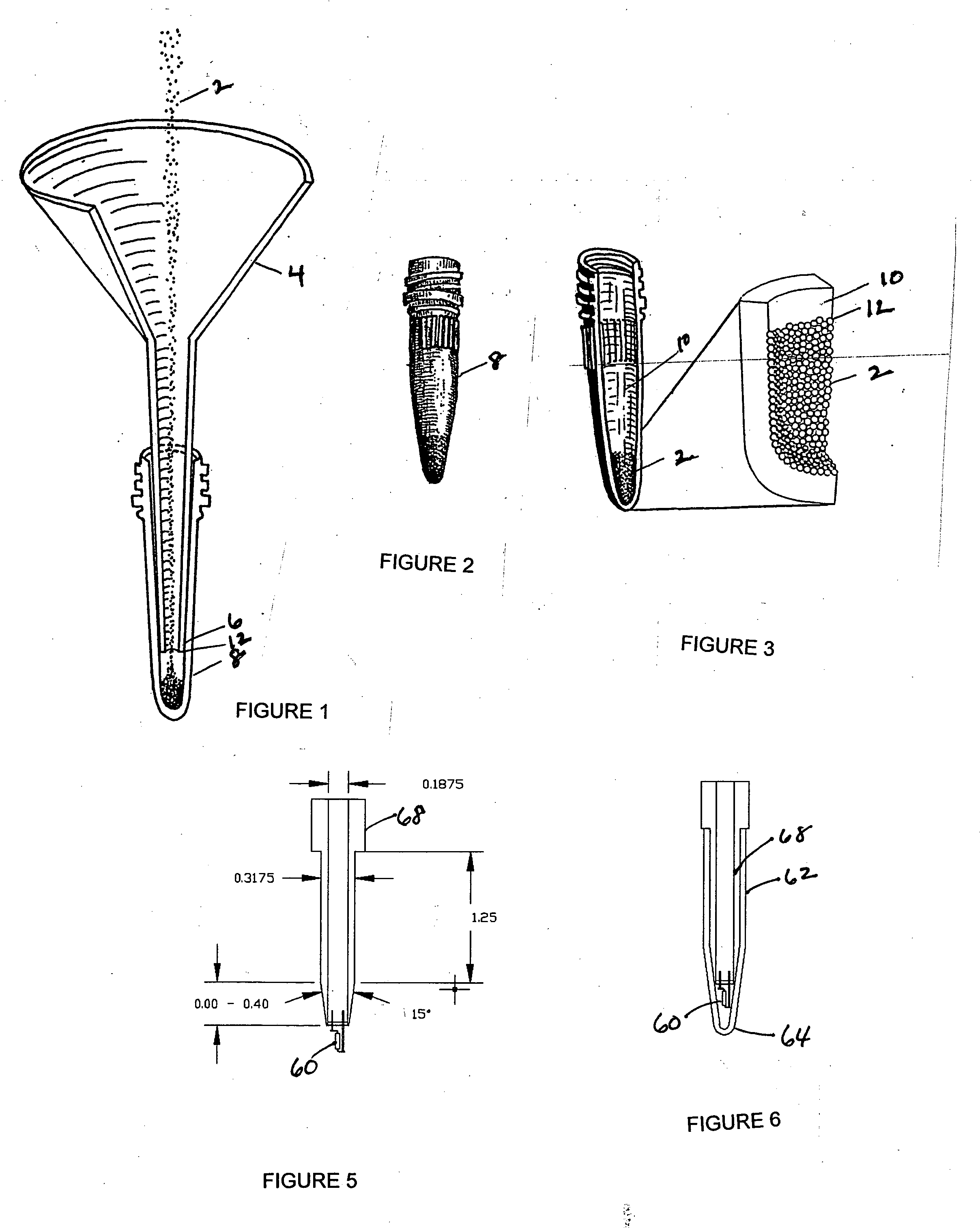Solid phase isolation of proteins, nucleic acids and other macromolecules
a technology of protein and nucleic acid, applied in the field of solid phase isolation of proteins, nucleic acids and other macromolecules, can solve the problems of difficult to remove the molecule of interest from the microtiter plate, polystyrene is not stable, and the typical amount of a molecule is not allowed to perform further tests
- Summary
- Abstract
- Description
- Claims
- Application Information
AI Technical Summary
Benefits of technology
Problems solved by technology
Method used
Image
Examples
example 1
[0059] Bonding of glass beads to the inner walls of microcentrifuge tubes. Acid-washed glass microbeads, 425-600 μm diameter, were obtained from Sigma-Aldrich Co.; 3-aminopropyltriethoxysilane and dimethyl suberimidate were from Pierce Chemical Co.; and conical polypropylene microcentrifuge tubes [12.6 mm (O.D.)×47.6 mm (L), 1.5 ml volume, screw-cap with O-ring] were from Fisher Scientific.
[0060] Glass microbeads were heated to 455° C. in a round bottom flask by upper and lower heating mantles under control of a microprocessor-controlled temperature regulator. The heated beads were added to microcentrifuge tubes by pouring through a glass funnel inserted into the tubes (see FIG. 1). The high temperature of the beads melted the superficial layer of the inner wall of the tubes, and the beads became bonded to the tube wall; excess beads which did not bond to the tubes were returned to the round bottom flask. Within the tapered portion of the microcentrifuge tubes, the height of the be...
example 2
[0063] Immobilization of protein A or protein G on glass Microbeads. After bonding the glass microbeads to the wall of the centrifuge tubes, protein A or G was immobilized on the glass beads. To accomplish this, free Si groups on the bead surface were first reacted with aminopropyltriethoxysilane to yield free amino groups; aminopropyltriethoxysilane diluted 1:5 in acetone was incubated at room temperature for 5 min with the bonded beads, and the beads were washed three times with acetone and three times with 100 mM Hepes, pH 7.4. The homobifunctional imidoester dimethyl suberimidate was then used to cross-link the free amino groups on the surface of the glass beads to amino groups of protein A or G. This reaction proceeded for 1 h at 4° C. using 1 mM dimethyl suberimidate and 1 mg / ml of protein A or G in 100 mM Hepes, pH 8.5. Under these conditions, the preferred reaction is with the α-amines of the proteins rather than with epsilon amines of glutamine and asparagine. The reaction ...
example 3
[0064] Quantitation of protein A binding sites on glass microbeads. The number of protein A binding sites on the glass beads bonded to the wall of microcentrifuge tubes was determined by two different methods. In the first method, 50 μg of rabbit IgG in HNMN buffer (50 mM Hepes, pH 7.5, 150 mM NaCl, 5 mM MgCl2, 1% Nonidet P-40) was added to the tubes, and the tubes were shaken gently for 2 h at 4° C. to allow for binding of the rabbit IgG to the immobilized protein A. The beads were washed three times with Tris buffer and IgG bound to the beads was measured by the Bradford method using bovine serum albumin as a standard.
[0065] In the second method, 2-10 μg of 125I-labeled rabbit anti-mouse IgG (specific activity 10 μCi / pg) was added to the tubes, and after a 1 hour incubation and six washes, the amount of immunoglobulin bound to the beads was determined by gamma counting and comparison to a standard curve.
[0066] Upon analysis of total protein bound to the glass beads, it was deter...
PUM
| Property | Measurement | Unit |
|---|---|---|
| melting point | aaaaa | aaaaa |
| melting temperature | aaaaa | aaaaa |
| diameter | aaaaa | aaaaa |
Abstract
Description
Claims
Application Information
 Login to View More
Login to View More - R&D
- Intellectual Property
- Life Sciences
- Materials
- Tech Scout
- Unparalleled Data Quality
- Higher Quality Content
- 60% Fewer Hallucinations
Browse by: Latest US Patents, China's latest patents, Technical Efficacy Thesaurus, Application Domain, Technology Topic, Popular Technical Reports.
© 2025 PatSnap. All rights reserved.Legal|Privacy policy|Modern Slavery Act Transparency Statement|Sitemap|About US| Contact US: help@patsnap.com



